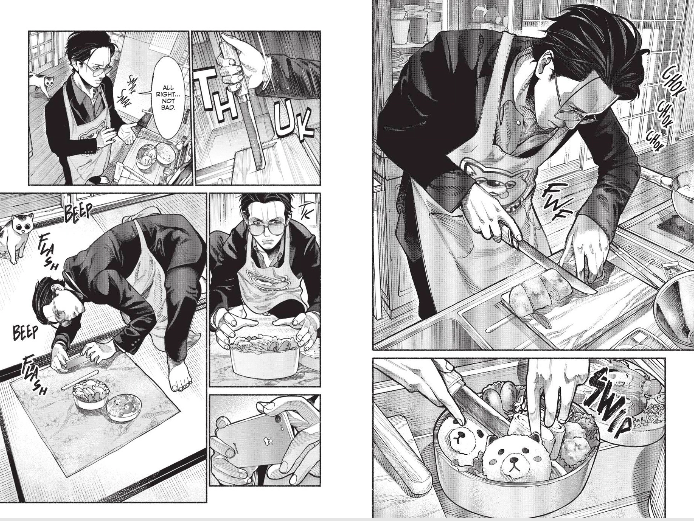The Way of the Househusband has the rhythms of a good sitcom: it has a simple, well-defined premise, a few lead characters with strong personalities, and an episodic formula that’s flexible enough to create endless opportunities to tell the same joke in new and surprising ways. In the first volume, for example, almost every storyline revolved around Tatsu’s fanatical dedication to his role as stay-at-home spouse, whether he was bargain hunting at the grocery store or racing to the train station with his wife’s lunchbox. The mere sight of him in an apron, track suit, and aviator glasses was a good sight gag made better by Tatsu’s sheer cluelessness; he never seemed to realize that people were staring at him in the checkout line and the butcher’s shop.
Volumes two and three find Tatsu in equally incongruous situations. In chapter 10, for example, he joins the neighborhood housewives’ aerobics class, flashing his terrifying yakuza sneer every time the instructor commands her charges to “smile,” while in chapter 16, Tatsu demonstrates a hidden talent for spiking and setting when he joins the ladies’ volleyball team. The volleyball game is a great variation on the series’ best running joke. Though most civilians find him a terrifying oddity, the neighborhood ladies’ association looks at Tatsu as one of their own; they include him in activities, offer him tips on how to run his household more efficiently, and even help him impress a former boss with an impromptu display of culinary prowess.
Perhaps the most important development in volumes two and three, however, is the introduction of Tatsu’s old enemies, all of whom are genuinely bewildered by his retirement from the knee-capping business. These exchanges thrum with the comic energy of a Damon Runyon story as Tatsu schools his fellow yakuza on stain removal and dessert making. That Tatsu discusses his career change without apology or explanation is a nice touch, as it throws his opponents off their game and reinforces the idea that he likes being a stay-at-home husband.
My only concern about The Way of the Househusband is that Tatsu’s wife is more a collection of moods and preferences than a fully persuasive character. Miku is marked by extremes: she has an intense, child-like obsession with Poli-Cure, an anime whose core fanbase is about ten years old, but is also a fierce workaholic whose resists Tatsu’s efforts to pamper her with scented candles and scalp massages. Though the gags built around her personality usually land, it sometimes feels like they’d be funnier if we understood a little more about how Miku and Tatsu met, or what keeps them together. From time to time, author Kousuke Oono hints the two have more in common than meets the eye–Miku is handy with a knife and a bat, too–but a little more attention to her character would be welcome.
That said, The Way of the Househusband remains consistently funny three volumes into its run, offering a fresh take on that most timeless of sitcom premises: the fish out of water. Recommended.
VIZ Media provided a review copy of volume two.
THE WAY OF THE HOUSEHUSBAND, VOLS. 2-3 • STORY AND ART BY KOUSUKE OONO • TRANSLATION BY SHELDON DRZKA AND AMANDA HALEY, ADAPTATION BY JENNIFER LEBLANC • VIZ MEDIA, LLC • RATED T+, FOR OLDER TEENS (SUGGESTED VIOLENCE, YAKUZA JOKES)
